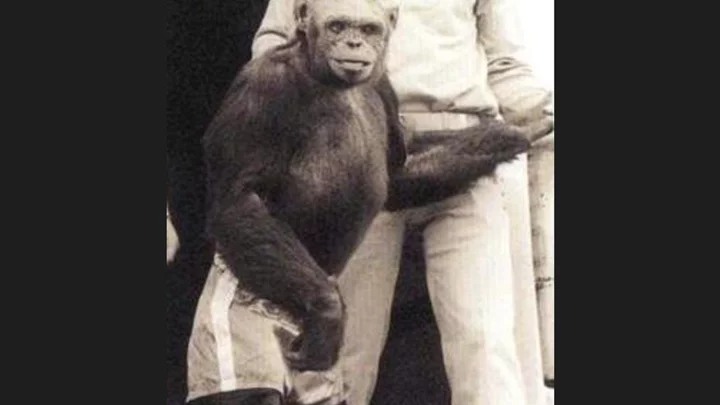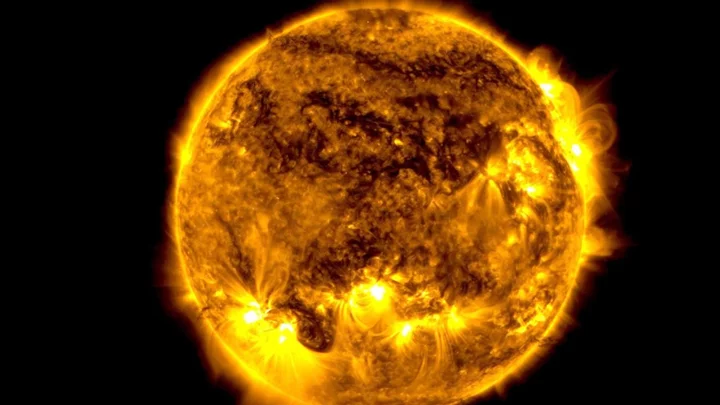
Biden cancels $72 million in student loan debt for borrowers who went to for-profit Ashford University
Even though President Joe Biden's student loan forgiveness program was blocked by the Supreme Court earlier this year, his administration is moving forward with more targeted student debt cancellations allowed under existing programs.
2023-08-31 04:29

Resurfaced Karl Lagerfeld quote sparks backlash after Chanel unveils food-less diner
A Chanel pop-up “diner” without any food has raised eyebrows, as many people have called attention to designer Karl Lagerfeld’s controversial comments about diet culture. This week, it was announced that the French fashion label would be opening an old-school diner in Brooklyn, New York, to celebrate the launch of its Chance Eau Fraîche perfume. What was once the Wythe Diner, located at 225 Wythe Avenue in Williamsburg, will be renamed the Lucky Chance Diner from 8 to 10 September. But don’t expect any diner food staples to be served at the pop-up restaurant. Instead, the immersive experience will include small, Chanel-branded treats and refreshments. As news surfaced that Chanel’s Lucky Chance Diner will not be serving classic American diner cuisine, like burgers and fries, many people were quick to note that the food-less menu would most likely receive a stamp of approval from Chanel’s late creative director, who had his own controversial opinions about food. In an Instagram post shared by popular fashion watchdog Diet Prada, the account resurfaced an infamous quote once uttered by Lagerfeld himself. “I never touch sugar, cheese, bread,” the German designer said. “I only like what I’m allowed to like. I’m beyond temptation. There is no weakness.” “When I see tons of food in the studio, for us and for everybody, for me it’s as if this stuff was made out of plastic,” he said. “The idea doesn’t even enter my mind that a human being could put that into their mouth. I’m like the animals in the forest. They don’t touch what they cannot eat.” Unsurprisingly, many people took issue with Lagerfeld’s past comments, and found it very fitting that Chanel would open a pop-up diner without actual diner food. “No sugar, bread or cheese? What a sad existence,” commented one Instagram user under Diet Prada’s post. “That quote is berserk,” another person said. “Thinking about the menu and all of a sudden I’m not hungry,” a third user wrote. This isn’t the first time Lagerfeld has been deemed problematic, notably for his fatphobic and body-shaming comments and controversial opinions about the MeToo Movement, migrants and LGBTQ rights. For example, when he was asked in 2012 whether he had a responsibility to hire size-inclusive models, the German designer said: “There are less than one per cent of anorexic girls. But there are zero in France, I don’t know in England - over 30 per cent of girls [are] big, big, overweight. And that is much more dangerous and very bad for the health. So I think today, with the junk food in front of TV, it’s something dangerous for the health of the girl. The models are skinny, but they’re not that skinny. All the new girls are not that skinny.” Although Lagerfeld claimed that he would “never touch sugar,” many people pointed to the 2001 “Karl Lagerfeld Diet” - which saw the designer lose more than 90 pounds as a result of a personalised diet plan created by Dr Jean-Claude Houdret. In his diet, Lagerfeld reportedly drank 10 cans of Diet Coke a day. “I drink Diet Coke from the minute I get up to the minute I go to bed,” Lagerfeld said, according to Women’s Wear Daily. “I can even drink it in the middle of the night and I can sleep. I don’t drink coffee, I don’t drink tea, I drink nothing else.” Despite his controversial opinions about food, Lagerfeld famously transformed the Grand Palais in Paris, France, into a supermarket for Chanel’s 2014 autumn/winter Paris Fashion Week runway show. The shelves were stocked with faux Chanel-branded products, with everything from “Jambon Cambon” ham to camellia-festooned rubber gloves. At Chanel’s Lucky Chance Diner, patrons can go on a “personalised scent discovery” to explore the brand’s new fragrance free of charge. The pink-and-green themed space will feature Chanel’s recognisable round perfume bottles on every surface, along with matching dining booths, countertop seating, napkin holders, clocks and other paraphernalia bearing its signature logo. Customers will also be able to participate in interactive activities, such as selfies with a life-sized bottle of Chance perfume and a fragrance window to purchase Chanel perfumes. The Lucky Chance Diner is open to the public for three days, from 11am to 7pm, beginning 8 September. Chanel is offering limited 30-minute reservations here, but walk-ins are also welcome. Read More Chanel is opening a beauty-themed pop-up ‘diner’ with no burgers or French fries Karl Lagerfeld’s most memorable quotes about fashion, celebrities and body diversity Should I give up Diet Coke? With aspartame under suspicion, an addict speaks
2023-08-31 03:57

19 Surprising Geography Facts That Will Change Your Perspective
Did you know that Australia is wider than the Moon? We've collected our favorite facts that will absolutely warp your sense of geography.
2023-08-31 03:46

Miley Cyrus says intense childhood work schedule has earned her an 'endless summer vacation'
Miley Cyrus is reflecting on her childhood work schedule.
2023-08-31 01:17

Fashion icon Iris Apfel celebrates 102nd birthday in style: ‘As beautiful as ever’
Style icon Iris Apfel has celebrated turning 102 years old in true “Barbiecore” fashion. Apfel reached the milestone age on Wednesday 29 August. In honour of her birthday, the fashion designer shared a pink-filled photo of herself to Instagram, with Kool & The Gang’s "Celebration” playing in the background. “102 today… who would’ve thought!!” she captioned the post, which featured animated pink balloons flying over her head. In the image, Apfel posed in her eccentric New York City apartment, complete with a white porcelain dog statue and a gold accent table. She was dressed in head-to-toe pink, along with her signature oversized, black round eyeglasses. Apfel wore a large, baby pink cape à la fellow icon André Leon Talley, and layered, chunky necklaces and bangles. She finished the look with salmon-coloured trousers, floral socks, and hot pink ballet flats with a bow. In the comments, many fans and famous friends rushed to wish the 102-year-old interior designer a happy birthday. “HBD, Iris!!!” wrote none other than the official Instagram account for Barbie. “You make 102 look fabulous!” said one fan. Another follower commented: “As beautiful as ever!” “Forever an icon,” a third person said, while someone else wrote: “What an achievement!” On Tuesday, Apfel also celebrated her birthday with an intimate dinner at Tutto il Giorno in the Hamptons, New York, where she was joined by designer Donna Karan, model Christie Brinkley, and Brinkley’s daughter, Alexa Ray Joel. The model shared a series of photos and videos with the fashion legend to Instagram in honour of her birthday. “Happy Birthday to Iris! She’s 102 and she’s got more style than me and you!” Brinkley captioned her poem-like birthday tribute. “She’s the queen of fashion who gets better every year, and today’s her birthday, did you hear? She’s got her trademark glasses and a wardrobe of fun and we wish her every happiness under the sun. “She’s smart and savvy and extremely witty and she wants everyone to know that individuality is always pretty, that we should all be ourselves, one of a kind,” Brinkley wrote. “Good advice like that’s hard to find. So thank you Iris for all you do, to say to people, ‘You do you!’ (Like you do so well!). Happy Birthday Iris! We LOVE YOU!” Apfel was born in 1921 in Queens, New York, to a father whose family owned a glass and mirror business, and a mother who owned a fashion boutique. Along with her late husband, Carl Apfel, she launched the textile firm Old World Weavers in 1950, which ran until they retired in 1992. Throughout her career, she took on restoration projects in the White House for nine US presidents. In 2005, she showcased her large collection of clothing and accessories in an exhibit at the Metropolitan Museum of Art’s Costume Institute, titled “Rara Avis (Rare Bird): The Irreverent Iris Apfel”. Her decades-long career in fashion and design became the subject of a 2015 documentary, simply called Iris. In 2019, she signed a modelling contract with global agency IMG at age 97. In an interview with Today following her 100th birthday, Apfel spoke candidly about her age and revealed why she’ll never retire. “Oh, I love to work. It’s fun because I enjoy it,” she said. “And then I can help people. I can give employment. People tell me I inspire them. So many good things come out of it.” “I think retiring at any age is a fate worse than death,” she continued. “Just because a number comes up doesn’t mean you have to stop.” Despite turning 100 at the time, Apfel explained that she didn’t see her age as a reason to “change” her lifestyle or career “overnight”. “I didn’t change overnight because the number changed,” she said. “I want to keep on working and doing different projects.” Instead, her motto at work is to “just do what [she]” feels and to do what she feels in her heart, rather than “verbalising” it. “I just feel it. If it feels right here,” she said, pointing at her heart. Read More 100-year-old fashion icon Iris Apfel reveals why she’ll never retire: ‘A fate worse than death’ Style icon Iris Apfel signs modelling contract with IMG, aged 97 Social media's 70-up 'grandfluencers' debunking aging myths Staggering environmental advantages of buying second-hand clothes revealed Why do we crave brand new clothes and how can we resist the urge to buy them? Chanel is opening a beauty-themed pop-up ‘diner’ with no burgers or French fries
2023-08-31 01:15

Texas power grid operator issues energy conservation appeal for Wednesday
The Texas power grid operator ERCOT (Electric Reliability Council of Texas) issued an appeal to residents calling for
2023-08-31 00:57

Geologists have figured out how to locate diamond ‘explosions’
A group of geologists has recently achieved a breakthrough in identifying potential sites for the formation of diamonds. Diamonds, the hardest naturally occurring material we have found, originate under the extreme conditions of immense pressure and high temperatures deep within the Earth's interior. These precious gems are occasionally pushed to the surface in molten rock formations known as kimberlite. However, there are currently two competing theories regarding what is responsible for this rush of kimberlite which brings diamonds to the surface. In a recent study, these theories were closely examined by a research team. In a piece for The Conversation study author and Associate Professor in Earth Science at the University of Southampton, Thomas Gernon explained: “one proposes that kimberlite magmas exploit the ‘wounds’ created when the Earth’s crust is stretched or when the slabs of solid rock covering the Earth - known as tectonic plates - split up.” “The other theory involves mantle plumes, colossal upwellings of molten rock from the core-mantle boundary, located about 2,900km [1,802] beneath the Earth’s surface.” However, neither of these theories adequately explains how magma manages to find its way through the Earth's crust, or the specific composition of the resulting kimberlite. By employing statistical analysis and machine learning, the team analysed the breakup of continents and its correlation with kimberlite formation. Their findings indicated that the majority of kimberlite volcanoes erupt 20 to 30 million years after tectonic breakup. “It also added a major clue,” Gernon explained. “Kimberlite eruptions tend to gradually migrate from the continental edges to the interiors over time at a rate that is uniform across the continents.” Delving deeper into their investigation through computer-generated models, the team ultimately concluded that diamond eruptions stem from a "domino effect." As continents gradually drift apart from each other, they generate rifts of thinned crust. As this happens, regions of thick, cold rock descend into the hot magma beneath, inducing an upsurge of the mantle, which in turn triggers a similar flow in nearby continents. Gernon elaborated on the team's findings, saying, "Various other results from our computer models then advance to show that this process can bring together the necessary ingredients in the right amounts to trigger just enough melting to generate gas-rich kimberlites,” Gernon explained. “Once formed, and with great buoyancy provided by carbon dioxide and water, the magma can rise rapidly to the surface carrying its precious cargo.” Moreover, the same methodology could potentially be employed to locate diamonds and other rare elements. “The processes triggering the eruptions that bring diamonds to the surface appear to be highly systematic,” Gernon siad. “They start on the edges of continents and migrate towards the interior at a relatively uniform rate.” The study is published in the journal Nature. Sign up to our free Indy100 weekly newsletter Have your say in our news democracy. Click the upvote icon at the top of the page to help raise this article through the indy100 rankings.
2023-08-31 00:18

Doctor says scientists secretly made a ‘humanzee’ by mixing humans with chimps
Chimpanzees are our closest relatives, so it’s not surprising that they can do many of the things that we can. They’re able to create tools and can even use sign language, plus they share 98.8 per cent of their DNA with humans. It is, therefore, no wonder that the question has often been asked: could humans and chimps ever produce offspring? The answer, according to one evolutionary psychologist, is yes – and it’s already happened. Gordum Gallup made the eyebrow-raising claims in an interview with The Sun Online back in 2018. He told the news site that a human-chimpanzee hybrid – which he dubbed a “humanzee” – was born in a Florida lab 100 years ago. And if you’re wondering how the scientists behind the experiment managed to keep it hushed up for decades, it’s because – according to Gallup – they swiftly killed the infant when they realised the implications of what they’d done. Gallup, a professor at New York’s University at Albany, said his former university teacher told him that the secret birth took place at a research facility in Orange Park, where he used to work. “They inseminated a female chimpanzee with human semen from an undisclosed donor and claimed not only that pregnancy occurred but the pregnancy went full term and resulted in a live birth,” the psychologist told The Sun. “But in a matter of days, or a few weeks, they began to consider the moral and ethical considerations and the infant was euthanised.” Putting Gallup’s unsubstantiated story to one side, it’s unclear whether a human-chimpanzee hybrid is even possible. Some experts believe that our human ancestors and chimpanzees may have been capable of interbreeding as late as 4 million years ago according to IFL Science, which notes that our last common ancestor lived 6-7 million years ago. However, the website also notes that this theory is widely contested. It also points out that other animals with similar genetic differences to that of humans and chimps, such as horses and zebras, have been able to reproduce. And yet, the offspring are often infertile. Nevertheless, back in the 1970s, plenty of people believed that a chimp called Oliver was a human-monkey hybrid thanks to his humanistic walk, intelligence and physical features (he was said to have a smaller, flatter face than his ape peers, according to Historic Mysteries). It wasn't until tests were conducted on Oliver in 1996 that the matter was finally settled: he had 48 chromosomes so was categorically not a humanzee but a regular chimp. Oliver The Humanzee www.youtube.com Still, one certainty is that scientists continue to tread an ethical tightrope when it comes to investigating chimps and their potential to further biomedical research. In 2021, scientists created the first (publicly documented) part-monkey, part-human embryo by growing human stem cells in a macaque monkey. The aim of the work, which was carried out at California’s Salk Institute, was to help create organs for transplants and improve our understanding of human development and disease progression. In 2020, a team of German and Japanese scientists spliced human genes into the brains of marmosets, resulting in the monkey fetuses having larger, more human-like brains, according to the study, which was published in the journal Science. Once the experiment was complete, the team destroyed their creations “in light of potentially unforeseeable consequences with regard to postnatal brain function”. One thing’s for sure, no scientist wants to find themselves the architect of a real-life Planet of the Apes. Sign up for our free Indy100 weekly newsletter Have your say in our news democracy. Click the upvote icon at the top of the page to help raise this article through the indy100 rankings.
2023-08-31 00:17

Scientists troubled by 'doomsday glacier' discovery
Scientists have been left shocked and worried by a recent discovery made beneath the Thwaites Glacier in Antarctica, otherwise known as the 'doomsday glacier.' The huge amount of ice has been destablised and has been reduced by nearly nine miles since the 1990s. It is believed to hold a large amount of water, that if it were to completely melt would raise sea levels by more than 2 feet around the globe and could unleash more water if neighbouring glaciers are disturbed. Now, new research carried out at the location in West Antarctica that deeper cracks are beginning to form on the shelf of the glacier potentially compromising its intergrity, as published in a study on the science journal Nature. Scientists used a robot named 'Icefin' to bore 2000 ft down below the glacier's surface to get a better look at what is going on beneath it by taking photos and videos as well as collecting valuable pieces of data about temperature and sea levels. What they found wasn't very reassuring. Although the rate of the melting wasn't as fast as they had originally feared the researched still painted a "very nuanced and complex picture." Speaking to CNN, lead researcher Peter Davis said: "The glacier is still in trouble. What we have found is that despite small amounts of melting there is still rapid glacier retreat, so it seems that it doesn’t take a lot to push the glacier out of balance." However, it wasn't all doom and gloom as robot creator and scientist Britney Schmidt of Cornell University, revealed that signs of life had been found on the glacier. She said: "To accidentally find them here in this environment was really, really cool. We were so tired that you kind of wonder like, ‘am I really seeing what I’m seeing?'. "You know because there are these little creepy alien guys (the anemones) hanging out on the ice-ocean interface. In the background is like all these sparkling stars that are like rocks and sediment and things that were picked up from the glacier. And then the anemones. It’s really kind of a wild experience." That being said, Oregon State University ice researcher Erin Pettit, who didn't work on the study believes that the findings are a cause for concern. She told Associated Press: "Thwaites is a rapidly changing system, much more rapidly changing than when we started this work five years ago and even since we were in the field three years ago. I am definitely expecting the rapid change to continue and accelerate over the next few years." Have your say in our news democracy. Click the upvote icon at the top of the page to help raise this article through the indy100 rankings.
2023-08-30 23:29

Billie Eilish receives BRIT Billion Award for incredible streaming landmark
Billie Eilish has followed in the footsteps of the likes of Queen, ABBA, Whitney Houston, Lewis Capaldi and more.
2023-08-30 23:26

Part of the sun is broken and scientists are baffled
We don’t want to alarm anyone, but the sun is broken. A section of the sun has left the surface and begun circulating around the top of the star as if it were a huge polar vortex, and it’s not exactly clear why it’s happened. The observation was made possible thanks to the James Webb Space Telescope, and its no surprise that it piqued the interests of scientists everywhere. Tamitha Skov is a space weather physicist who regularly shares updates on social media, and she seemed incredibly excited about the latest developments. Sign up for our free Indy100 weekly newsletter “Talk about Polar Vortex! Material from a northern prominence just broke away from the main filament & is now circulating in a massive polar vortex around the north pole of our Star,” she wrote. “Implications for understanding the Sun's atmospheric dynamics above 55° here cannot be overstated!” Solar prominences consist of hydrogen and helium, and they extrude from the sun’s service releasing plasma. While there’s confusion around the cause of the phenomenon, it could be related to the reversal of the sun’s magnetic field, as well as the fact that something expected has been known to happen when the sun reaches a 55 degree latitude in every 11-year solar cycle. Solar physicist Scott McIntosh, who is the deputy director at the National Center for Atmospheric Research in Boulder, Colorado told Space.com: "Once every solar cycle, it forms at the 55 degree latitude and it starts to march up to the solar poles. “It's very curious. There is a big 'why' question around it. Why does it only move toward the pole one time and then disappears and then comes back, magically, three or four years later in exactly the same region?" Have your say in our news democracy. Click the upvote icon at the top of the page to help raise this article through the indy100 rankings.
2023-08-30 22:47

J&J, India's Lupin cut prices for tuberculosis drug in lower-income countries
Johnson & Johnson and Indian drugmaker Lupin will supply their versions of the tuberculosis drug bedaquiline at a
2023-08-30 22:19
